Is there a perfect body? How to get it? The perfect body ideal for a man or woman has changed over time. We invite you to tour with us the evolution of ideal physiques. Learn how to get a fitness body .
The evolution of the masculine body throughout history
If you look at your social media any day of the month, you will see several photos of men without shirts. Many of them have bodies that appear to have been flayed by the gods. However, you will also notice that most of these guys are not muscular mountains like Arnold Schwarzenegger. They are much leaner versions of the Fitness physique with virtually no visible fat.
Lean physiques have been popular for decades, but this is certainly a far cry from the body that was "supposed" to be ideal in years gone by. You may be surprised to learn that, in the late 19th century, for example, it was ok to be fat because it meant you were rich enough to eat banquets. There were even clubs for fat men in the United States, which required a minimum weight of 200 pounds/90 kilos to join! Today, 90kg is considered average, and many training warriors are trying to break the 100kg barrier.
If we go back even further in time to the ancient Greeks, a muscular god-like body would bring you divine status among your peers.
The perfect body and social media
Platforms for sharing our personal photos, such as Instagram or Facebook, have become increasingly popular. Keeping up with the latest trends in how we should look under our clothes is almost as complicated as choosing the clothes themselves. Especially now that it seems to have come full circle, as most men still want to see themselves with ripped bodies , but not necessarily with an extreme deficit of body fat like the bodybuilders of 2010.
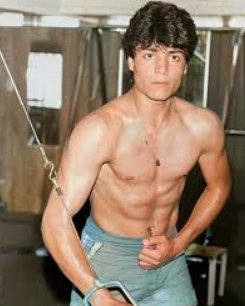
Do you know the Adonis complex ? It is a psychological disorder, which consists of being obsessed with obtaining a perfect and muscular body . This problem is also called vigorexia or muscle dysmorphia. Dr. Harrison Pope, a professor of psychiatry at Harvard University, wrote a book called "The Adonis Complex." Here, he looks at the ways in which the media manipulates and distorts the idea of the ideal body type, particularly for men. We were used to the idea that women had to conform to certain magazine ideals, but things are not easy now for men either.
Another professional, in this case of physical transformations, is Andy Anderson, founder of the Ultimate You Change Center. We asked him if he's noticed any changes in body shape trends, what's causing it, and what the next men's bodies might look like.
Andy explains that the 'surfer beach body' look became popular in the late 1990s and early 2000s . This ideal body had a 'slim, healthy and tanned' look. However, not everyone wanted this type of physique. Bodybuilders still had shrines to Schwarzenegger and Stallaone. They worked their muscles to get bigger and bigger to the extreme. "In the last five years, it's become more of a social norm for men to exercise, have more muscle mass and focus on being strong."
“Guys are looking for a Wolverine look: a defined body , with hard, solid muscles. The social media Instagram has contributed to this ideal”.
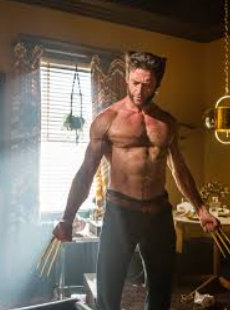
Instagram has been something of a bible for women about how they should look, and the social media has played a similar role for men. Sure, we can be fit and strong, but if we want to get likes for our photos, we need to be fit too. Andy thinks that social media definitely influences society and the marketing of the 'ideal' body shape or perfect body. This ideal used to come from magazines; now, it comes from social media. It is a fact that more men want a defined, firm and toned appearance. There is also a lack of understanding of what it takes to achieve it!
Instagram did not always influence our decisions. Before, we used to turn to magazines and the big screen to determine how we should look and how we should dress. According to TheList.com, in the 1950s and 1960s, the "executive look" was all the rage. Men wanted to look big but without muscle, so they wore tops that were looser than today's skinny, fitted models.
How was the ideal body of a man in the 60s and 70s
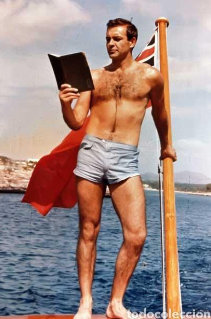
Ideal bodies slimmed down a bit in the late 1960s and 1970s. Then Sean Connery became the first James Bond. This actor showed off a slightly firmer body, although his abs were not yet visible. However, his suit was cut closer to his torso and his chest was hairy. To many, Connery is the epitome of a "manly man." Not everyone sticks to the 'ideal', of course; some choose to deviate from the path. Take Leonardo DiCaprio, for example. The 45-year-old actor championed the 'daddy body' look in 2016. Many men saw it as an opportunity to get caught up in the trend.
We think you should be able to do whatever you want with your body, and leave the glowing headlines of "daddy's body mania" to those stuck in 2016. Is this body healthy? It is best to ask the experts to find out.
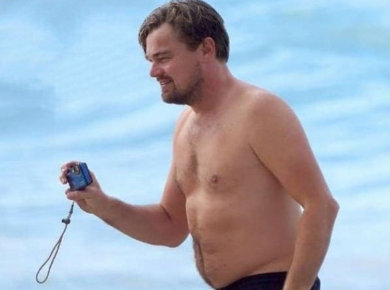
What is the correct or healthy male body?
Fitness expert Andy says "daddy's body" can be fine, but there are some strings attached. "What we accept is very personal, but we should all value our bodies and our lives based on how we feel on a day-to-day basis." We should ask ourselves the following questions: "Do I feel good and energetic? Am I maintaining my energy throughout the day? Do I feel happier? Do I think more clearly? Am I more motivated?" Don't just focus on "how I look."
Certainly, having a slimmer, healthier, and smaller waistline is just a reflection of healthy eating and proper exercise. You'll lose that "daddy body" if you focus on healthy eating and exercise, but first pay attention to how you feel.
The ideal body of man according to different times
What then is an ideal body? The truth is that this cannot be absolutely defined. The beauty canon is as changeable as the different eras. Therefore, those who consider themselves to be men with perfect bodies today are not the same as they were 50 or even 200 years ago. How has the masculine ideal changed? Let's see!
1870
In the 1870s, when food was scarce, the ideal body was chubby and broad-waisted. This meant that you had money to eat well.
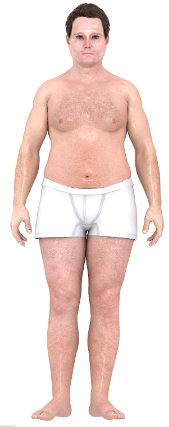
1930
When food became accessible to everyone, the ideal male body changed. Now, the fashion was to be skinny.
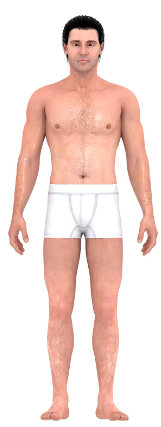
1960
In the 1960s, the "hippy" culture and anti-social movements arrived. Back then, it was still fashionable to be thin and have long hair.
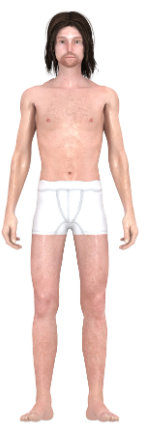
1980
Here, came the time of the bodybuilder. The ideal physique became a muscular body.
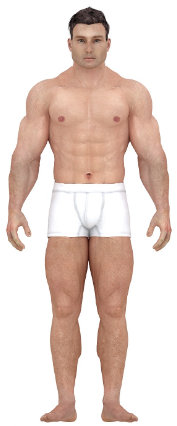
1990
In the 90s, the perfect body that we know arrived, with defined muscles, but not as exaggerated as in 1980.

How to get the perfect male body according to science?
The perfect male body according to today's ideals is a muscular physique (without being exaggerated) and with low body fat. However, it is not about adding muscles for the sake of adding, but about keeping certain proportions. Have you set out to achieve the physical ideal? Let's look at some key things you should know about it.
- • You can make your body more attractive by improving muscle proportions according to a formula known as the Greek ideal .
- • According to this Greek ideal, your flexed arms and calves should be 2.5 times larger than your non-dominant wrist, your shoulders should be 1.618 times larger than your waist, your chest should be 6.5 times larger than your wrists. and your thighs should be 1.75 larger than your knees.
- • Most people don't have the genetics to achieve these perfect body goals, but anyone can get close enough to the goal of getting a great physique (read on to find out how!).
Let's be honest: at least half of the reasons most of us exercise is to look good. You know, being muscular, slim, fit... We want to know how to get an aesthetic body , as Fitness influencers like to say. Getting a perfect body today requires the following specific objectives:
- • Broad shoulders and toned biceps and triceps.
- • Large, flat chest in a V-shaped torso.
- • Narrow waist and firm abdomen.
- • Legs developed and strong.
There's nothing wrong with wanting an ideal body. People are always looking for "tricks" and shortcuts to a better life, and looking good is important. When you are physically attractive , you are more confident, people like you more, and they treat you better, which has a positive impact on all aspects of your life.
How to get a defined , fit and beautiful body ? Through 'bodybuilding' of course, but nowadays you have to be careful with this term. The best bodybuilders are often associated with an extraordinary amount of muscle mass, and are more akin to a hybrid between a human and a beast. However, this has not always been the case.
Once upon a time, before steroids, bodybuilders wanted to look like athletes in their prime or ancient warriors, not mountains of anabolic muscle. An example is Eugen Sandow, from the late 1800s, before testosterone was synthesized.
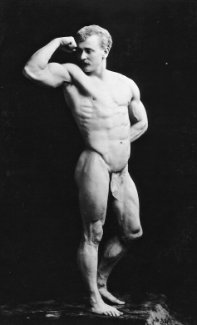 |
| Eugen Sandow. |
Sandow featured the most attractive male body shape. However, he would be considered "small" and not overly defined by modern bodybuilding standards. The physique of this ancient bodybuilder was excellent in terms of overall muscularity, proportions, and body fat. Plus, he's the pinnacle of what most natural bodybuilders could hope for. It's safe to say that most guys would love to look like Eugen.
Another good example of a perfect body is bodybuilding pioneer Otto Arco, who achieved an incredible physique in the early 20th century. And finally, we'll mention George Hackensmith, a contemporary version of Sandow and Arco (and the inventor of the famous bench press exercise).
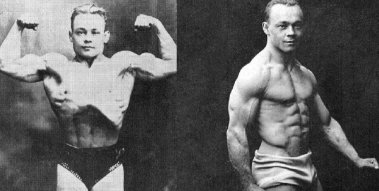 |
| Eight Arc. |
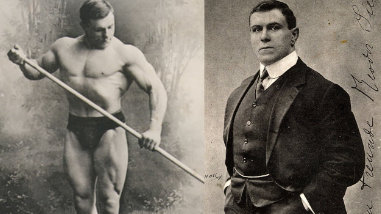 |
| George Hackensmith |
The men we've talked about couldn't just increase their dedication to gaining muscle to infinity. They searched for the perfect balance between size and symmetry . These ancient bodybuilders literally became the epitome of the essence of male beauty: muscular development with the correct balance, proportion, and definition.
Also, nothing these bodybuilders did is beyond the reach of the common man. Although we can't build our ideal bodies exactly like Eugen, Otto or George, we can reach a level close to it with enough hard work and patience. That's what we'll talk about in this article: we'll take a deep dive into what creates the appearance of the ideal male body and how we can get there.
Achieving a perfect male body is much simpler than you think! The key to it all is applying a mathematical relationship known as the golden ratio . Learn about the ancient formula that determines the proportions of the 'ideal' male body . Learn how to compare your body to these standards so you know which parts of your body need the most work. How close can you get to the numbers based on your genetics? Finally, learn how to eat and exercise to develop the perfect male body.
The golden ratio and the perfect male body
How to get an athletic body? The architect, writer, and engineer Marcus Vitruvius spent most of his life building siege weapons, forts, and camps to support Julius Caesar's European visits. Marcus published the work "De Architectura". Since then, it has become one of the most important modern sources of information on Roman construction, planning, and design methods, including drawings and materials for cities, temples, civil and domestic buildings, pavements, aqueducts, and other projects.
Vitruvius's publication also included the ideal human proportions , which he believed guided the construction of the sacred temples. In fact, the artist argued that the human body corresponded to the latent geometry of the universe itself and was therefore a microcosmic representation of the physical world.
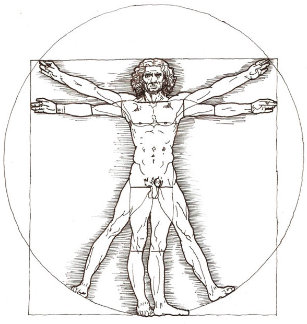 |
| The vitruvian man. |
More than fifteen hundred years later, around 1487, Leonardo da Vinci drew a human figure based on Vitruvius's observations and named it "Vitruvian Man" . Like Vitruvius, da Vinci was fascinated by human anatomy and believed that "man was the model of the world." The Vitruvian man became a model of ideal masculine proportions . Scholars later discovered that its balance and beauty were due to the use of a mathematical relationship called the divine proportion or golden ratio.
The golden ratio was defined for the first time by Euclid in his work "Elements" from the year 300 BC. C. The concept is simple: two quantities are in the golden ratio if the ratio of the sum of the quantities to the greater quantity is equal to the ratio of the greater quantity to the lesser quantity.
Visually, it looks like this:
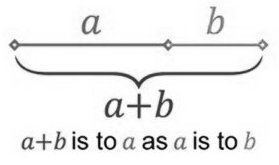 |
| Formula of the golden proportions. |
Numerically, it is expressed as 1:1,618 (from 1 to 1,618). In the case of the previous figure, "b" is 1 unit long and "a" is 1.618 units long. The fascinating thing about the golden ratio is that it is not an abstract thought experiment, but rather appears to be a law of nature. Scientists have observed it everywhere in nature, including in the arrangement of branches and leaf veins on plant stems, in the skeletons of animals and the arrangement of their veins and nerves, in the composition of chemical compounds and the geometry of crystals. Researchers have recently reported that the relationship exists even at the subatomic level.
Yet nowhere is the golden ratio more apparent than in the human body. There are many examples of this proportion on the face. The head forms a golden rectangle with the eyes in the center. The mouth and nose are at a golden distance between the eyes and the lower edge of the chin. The spatial relationship of the teeth and the structure of the ear also reveal the golden ratio.
The golden ratio is also reflected in the general proportions of the human body, in the different lengths of the bones of the fingers, toes, and toes, and even in the structure of DNA. Also, as da Vinci pointed out long ago, the more the body follows the golden ratio, the more beautiful it is perceived to be .
For centuries, artists have used this ratio to create more attractive figures. More recently, plastic surgeons and cosmetic dentists have used it to create more attractive faces and mouths for body aspirants .
Some scientists have pointed out that all kinds of equations can be found in nature if you search hard enough, but the golden ratio is so common that it cannot be considered a coincidence. The golden ratio is also useful for our purposes of achieving a great body. By adjusting the size of different parts of our body relative to other parts to match this ratio, we can enhance our visual appeal .
This is also not a new concept. Eugen Sandow was the first person to popularize this approach to bodybuilding and used it to create one of the most impressive physiques of his time. In short, the golden ratio is a specific geometric relationship that occurs in nature and is used by artists, architects, and plastic surgeons to create a beautiful sense of symmetry and proportion. If you apply this ratio to your muscles, you can make your body more attractive.
How to get a good body according to the "Greek ideal"
Sandow was famous for evoking classical Greek and Roman sculptures depicting the ideal male body : a small waist that flares upward to form a broad, muscular chest and shoulders, balanced by strong legs. Sandow leaves the best representation of him, for example, of Glykos's statue of Heracles, who was the pinnacle of physical perfection for the ancient Greeks:
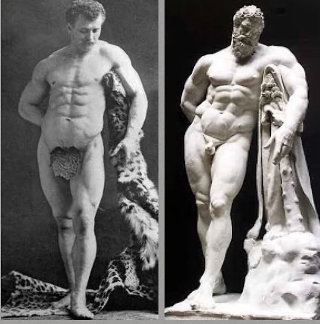
Its striking resemblance to the statue was not coincidental. Sandow measured the statues in museums that he was trying to resemble and found that they shared certain proportions between body parts. He drew on this observation to develop a model of the ideal physique, which he called the "Greek ideal" . Unbeknownst to him, his system revolved around the golden ratio and later served as a model for future bodybuilders who became famous for their proportions, including Steve Reeves, Frank Zane, Serge Nubret, Bob Paris, and Arnold Schwarzenegger . Perhaps no one represented this approach to bodybuilding better than Frank Zane, who had some truly outstanding proportions and symmetry:
So what is this system? And how can it help us look like Greek sculptures? It all starts with setting reference points: certain parts of the body that determine how big other parts need to be in order for the ensemble to be pleasing. Some of these points are wrist and knee circumference , which do not change with age or with increasing or decreasing body fat or muscle mass. Others, like the waist , do change.
For example, by measuring the circumference of your wrist, you can determine how big your arms should be, and based on this measurement, you can determine how big your calves should be. The size of your knees will tell you how big your thighs should be, and the size of your waist will tell you how wide your chest and shoulders should be. In other words, the recipe for the perfect male body is a set of simple and formulaic relationships between the parts of the body. How does it start?
Arms
Your flexed arms should be 150% larger than the circumference of your non-dominant wrist (wrist circumference x 2.5) .
- To measure the smallest part of the wrist, locate the bulge of the bone (styloid process) on the outside of the wrist, open your hand, and wrap the tape measure around the area between the bulge and the palm.
- To measure the flexed arm, wrap the tape measure around the largest part of the arm (the top of the biceps and the middle of the triceps).
Some say you should only measure your non-dominant arm, but we advise measuring both arms for best accuracy. This also helps to identify muscle imbalances between the right and left arm.
Also, take measurements under normal conditions (no pumping or carb loading for muscle gain). Otherwise, the numbers won't reflect your daily muscle level, which is what's important (not how you look thirty minutes after a workout or a big meal).
Some also say that this wrist-to-arm ratio refers to an unflexed arm, not a flexed arm. However, we do not agree with this statement.
If your wrist circumference is 18cm, while your arms measure 43cm flexed and 37cm unflexed, your arms should look balanced compared to your chest and shoulders. Suppose the ratio is applied to an unflexed arm; arms would have to measure 17 inches straight and over 20 inches flexed, which would look ridiculous and require heavy use of steroids. So even if you don't have a pronounced bicep peak, keep in mind the dimensions with your arm flexed.
calves
The measurement of your contracted calves should coincide with your flexed biceps .
- To measure a contracted calf, lift your heel, press your toes into the ground, and wrap the tape measure around the largest part of the muscle.
Shoulders
The circumference of your shoulders must be 1.618 times your waist (waist circumference x 1.618) .
This creates the coveted ideal male V body , which scientific studies have shown to be attractive to women .
- To measure your waist circumference, tape a tape measure around your natural waistline (above the navel and below the breastbone). Don't put your stomach in.
- And to measure the circumference of the shoulder, stand up straight and with your arms glued to your sides (do not bend your elbows or flex your shoulder blades). Have a friend run the tape measure across your shoulders and chest at its widest point. This is usually right at the top of the armpits.
Pectoral
The circumference of your chest must be 550% larger than the circumference of your non-dominant wrist (wrist circumference x 6.5) .
Although there are other ways to achieve your ideal breast size, this is the easiest and most reliable.
- To measure your chest circumference, stand up straight and place your arms at your sides (again, do not bend your elbows or extend your shoulder blades). Have a friend place a tape measure over the widest part of one of your pecs and wrap it around to the other pec. The tape measure should go under the armpits. The tape measure should be placed under the armpit, over the shoulder blades, under the other armpit, and back to the starting point.
- Then, take a normal breath (without expanding or deflating the chest too much) and record the measurement.
Thigh
The thigh circumference must be 75% greater than the knee circumference (knee circumference x 1.75) .
The real superman will have impressive "wheels". Are you able to achieve the target ratio in the legs?
- To measure knee circumference, straighten your leg and wrap a tape measure around the middle of the knee.
- To measure the circumference of the thigh, flex the thigh and wrap the tape measure around the widest part of the quadriceps and hamstring muscles.
If you have achieved these proportions or have come close to them, you will have obtained a mathematically perfect body. Now, is it difficult to achieve the objectives? How to get an athletic body like this ?
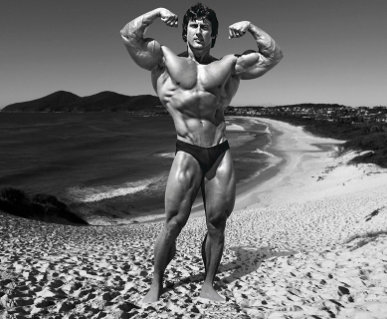 |
| Bodybuilder Frank Zane. |
Learn to compare your physique with the Greek proportions
Before using the tape measure, there is an important caveat: if your body fat is too high, the measurements you will take will be skewed and some parts of your body will be affected more than others. So if you want to take advantage of everything you just learned to see which parts of your body need to improve the most, you must lose weight first. In particular, we advise you to reduce your body fat percentage to around 10-12% , which is lean enough to show visible muscle without being unhealthy.
Measuring is simple. First thing in the morning, before eating or exercising, take the following measurements and write down the numbers:
- Non-dominant wrist circumference
- Measure arm circumference (both arms)
- Shoulder circumference
- Chest circumference
- Waist circumference
- Thigh circumference (both legs)
- Non-dominant knee circumference
- Calf circumference (both calves)
Then compare your numbers to the above formulas and write down your strengths and weaknesses. Let's see the example measurements of a person:
- Non-dominant wrist: 18 cm
- Arm: 43 cm
- Shoulder: 129.5 cm
- Chest: 109 cm
- Waist: 81 cm
- Thigh: 61 cm
- Non-dominant knee: 35.5 cm
- Calves: 38 cm
Here are the "ideal" numbers for this person:
- Arm: 44.5 cm
- Shoulder: 132 cm
- Chest: 115.5 cm
- Thigh: 63.5 cm
- Calves: 44.5 cm
Based on the above, this person would need to increase the size of the shoulders, chest, thighs, and calves. We agree? Shoulders always need more work (as a natural weightlifter, you can't have "too big" shoulders).
Working the lats more would considerably expand the perimeter of the chest. By bodybuilding standards, the legs of the person in the example would be slightly behind. Quite frankly, a lot of people don't want to have bigger thighs in order not to be unbalanced (and because finding the right pants is hard enough!). The calf muscles must be a certain size, but genetics sometimes make them difficult to form.
This brings us to another important question. While the Greek ideal provides useful reference points, we are not to regard it as dogma. Sometimes goals can be unrealistic (perhaps the person in the example will never have a 17-inch calf) or exaggerated. And if the pectoral already looks strangely large for an individual's size, there is no point in trying to increase it.
Just take your measurements, compare them to the model and decide for yourself where you agree. Adjust the training accordingly (if necessary).
Summary : To achieve the ideal male physique , you'll want your flexed wrists and calves to be 2.5 times larger than your non-dominant wrist, your shoulders to be 1.618 times larger than your waist, your chest to be 6.5 times larger than your your wrists, and your thighs will look 1.75 times bigger than your knees.
Can you get a golden body?
Applying the golden formula to body proportions gives us objective standards to aim for. However, as we know, our genes largely determine how close we can come to achieving these goals.

While it's impossible to be absolutely sure how big each of our muscle groups can grow, there are formulas that give reasonable estimates.
For example, thanks to the work of Dr. Casey Butt, you can use your height, body fat percentage, and wrist and ankle measurements to get an idea of how much your chest, biceps, forearms, neck, thighs, and calves can grow.
In the following link you can find the Casey Butt calculator , in English. It is very useful! If you take your measurements correctly and write each piece of information that the calculator asks for, you will know how close you are to reaching your genetic potential. You will be able to estimate how many kilos of muscle mass you could still gain naturally or how far the girth of your muscles could grow.
The two biggest mistakes most people make are not following a well-designed strength training program that applies progressive overload, and gaining body weight too quickly (gaining too much fat). Of course, the calculator is not a perfect tool nor does it reflect the best results, but it does give you a realistic estimate of how close each of your muscles can get to the ideal Greek proportions.
It's probably best to reduce the numbers on the calculator by about 5%. How far can you take your body? Try to follow proper nutrition and training for at least a decade. If you have been trying to achieve a good body at home or training in the gym for 10 or 20 years, take your body measurements and use the calculator. If you get very close to your ideal results, you won't have much muscle left to gain naturally (whatever you do). You will be very close to your genetic limits.
However, this does not mean that training should become boring and meaningless. Simply put, this means that your goals and expectations should evolve with your body. You have to learn to appreciate what you have and find a deeper motivation to keep going.
You can feel more confident and competent in and out of the gym, be more productive at work, set a good example for your children, take on new physical challenges (such as playing other sports, walking, cycling or running), avoid disease and dysfunction , or slow down the aging process and maintain youthful vitality.
If you've already reached your genetic muscle potential , keep exercising to stay fit and healthy for the rest of your life, pain-free and injury-free. Help your family develop a positive relationship with food and exercise. Throughout your coaching journey, you have learned lessons that you can pass on to your own children. It is about pride and personal responsibility, the physical expression of your values and worldview, about creating and expressing the best of yourself.
It is better to see all of this as a privilege and a reward, not a commitment or withdrawal. It's something to celebrate, not endure.
And if these numbers have discouraged you, you can rest easy. With the right plan and enough hard work, almost anyone can sculpt key muscle groups like the chest, shoulders, and arms. And this alone is enough to build a physique that is above average for weightlifters. You must build your own perfect body yourself !
If you can do this (and you can), plus make sure your legs aren't an obvious weakness, and then maintain a relatively low body fat percentage, you'll look fantastic!
Summary: Depending on your genetics, you may never be able to fully embody the Greek ideal, and with good reason! Achieve what you can and you will likely have an impressive physique.
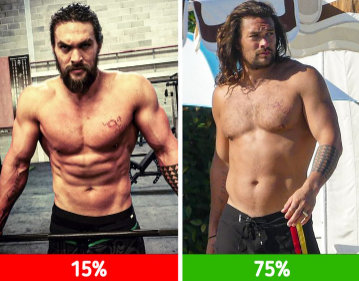 |
| What do the girls prefer? Fitness man body or "Dad Body"? |
Build your perfect body
Throughout history, opinions on what an ideal body is have changed. If you want to build a great physique, you need to do more than lift weights, eat food, and take supplements. This will give you size, but not proportion or symmetry, so you need to systematically build your muscles and your entire body.
Because of this, you must pay special attention to how you develop your muscles to aim for the correct proportions and symmetry. To do this, you can use a simple set of standards called the Greek ideal.
According to the Greek ideal, the flexed arms and calves should be 2.5 times larger than the wrist of your non-dominant hand, the shoulders should be 1.618 times larger than the waist, the chest should be 6.5 times larger that the wrist and thighs should be 1.75 times larger than the knees. Don't expect to get a perfect body in 3 months ! Reaching your ideal potential takes time.
Most people don't have the genetics to achieve these perfect body goals perfectly, but anyone can get close enough to enjoying a great body. It only takes a few years of well planned strength training programs and effective meal plans.

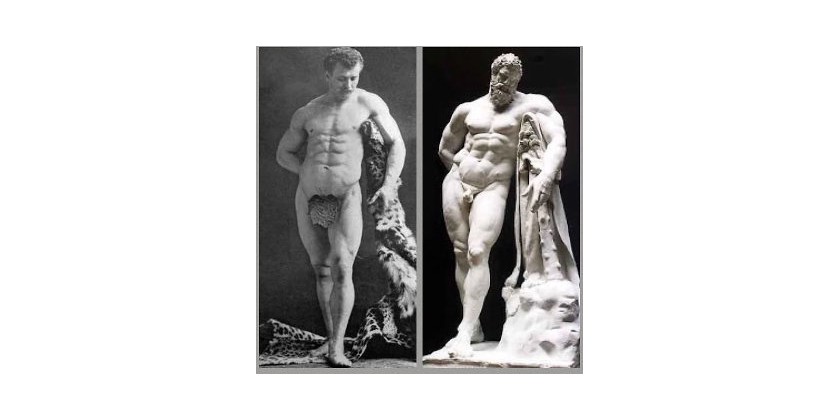


![CÓMO MONTAR UN GIMNASIO EN CASA CON POCO PRESUPUESTO [GUÍA 2024]](/modules//smartblog/images/296-home-small.jpg)




